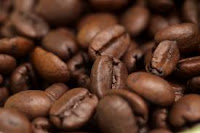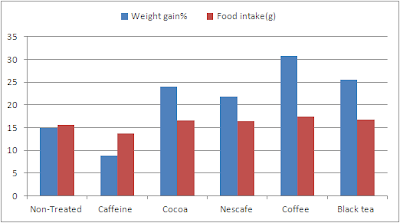 |
| Image 1: Already in "pill form" - Coffee beans |
Caffeine prevents weight gain - whohooo! Or not?
The scientists set out to investigate the differential effects the oral administration of 10mg/day of pure caffeine, or dose-equivalents from coffee, (black) tea, cacao and Nescafe (note: this is my understanding of the somewhat sloppy English translation of the methods) would have on the lipid levels of rats who had been pretreated with a lard-based high fat diet and CCl4 for three months. This treatment had elucidated the expected inflammatory response and fatty acid deposition in the livers of the animals that were then randomly assigned to either one of the 5 treatment or a non-treated control group.
 |
| Figure 1: Weight gain (relative to initial weight) and food intake in non-treated, caffeine, cacao, Nescafe, coffee, or black tea treated rodent model of NAFLD (data adapted from El-Ghany. 2012) |
High dose caffeine is for NAFLD sufferers not!
Looking at the rest of the data it became increasingly clear, the whopping dose of 10mg of caffeine per rodent per day, a dose, by the way, which happens to translates into a human equivalent dose of 10mg/kg (i.e. 800mg for an 80kg adult), did a pretty decent job in liberating fatty acids from the adipose tissue. So "decent", in fact, that the already compromised weight gain in those sick creatures was further attenuated.
 |
| Figure 2. Lipid levels in the treatment groups expressed relative to non-treated NAFLD rodents (left); selected liver slices (right; based on El-Ghany. 2012) |
 |
| Figure 3: Total cholesterol (CHO) and LDLc to HDL-c ratios in the non-treated, as well as the treated groups expressed relative to non-NAFLD control (data calculated based on El-Ghany. 2012) |
Upon liberation from the adipocyte, fatty acids are transported to the liver, where they are reesterified and the resultant triglycerides packaged for release in very-low-density lipoprotein (VLDL), which also contains apolipoprotein B.If we assume that this hypothesis is correct, coffee, cacao and even Nescafe must obviously contain substances which help the liver to cope with the additional influx of fatty acids, as the animals in the respective groups do not only have significantly lower VLDL levels than the poor critters in the caffeine group, but also exhibit the most beneficial total cholesterol-to-HDL and LDL-to-HDL ratios (cf. figure 3) of all groups.
Say no to stims, energy drinks and coke and chose natural caffeine sources
In view of the ameliorative effects all the caffeine containing preparations had on the pathological features of NAFLD (cf. figure 2, right), and based on the results from previous studies and the assumption that the VLDL increase in the tea group was similarly well-handled in the rest of the body as it was in the liver, which did not present any of the congested veins that were so characteristic of the livers of the animals in the caffeine only group, the take home message of this study is one every SuppVersity student should be familiar with, by now: Nature knows best!
 |
| Image 2: I don't have to tell you that the study at hand suggests that those sugary caffeine bombs people call "energy drink" could give many of their livers their quietus. |
While Coffee, tea and cacao drinkers can thus breathe a sigh of relieve, the average stim junkie who is already squirreling caffeine laden, geranium (DMAA) intoxicated pre-workout supplements and fat burners for the days after the DMAA ban, should better watch his liver health. Otherwise it may well be that he or she will end as a "case study" in the library of the FDA - filed under "death by fulminant liver failure induced by geranium + caffeine containing pre-workout supplement" - btw. isn't it strange that the FEDs don't have such a case study for one of the commercially available energy drinks, or even plain Coke, already?
